To declutter like a pro, start by identifying your space and gathering supplies. Set a timer to stay focused, and create a checklist to guide you. Tackle small areas first for quick wins, and use the Four-Box Method to sort items. Efficiently organize and store belongings, and pay attention to specific clutter hotspots. Then, maintain your clutter-free environment with daily routines. Stick around to discover more effective strategies to streamline your decluttering journey.
Key Takeaways
- Identify a specific room for focused decluttering and assess its condition for organization needs.
- Gather essential supplies like boxes, trash bags, and organizers to streamline the decluttering process.
- Create a checklist categorizing tasks by room, applying decluttering rules for effective decision-making.
- Establish daily routines and schedule seasonal decluttering sessions to prevent clutter buildup.
- Embrace minimalism by regularly evaluating belongings and maintaining a system for important documents.
Identify Your Decluttering Space
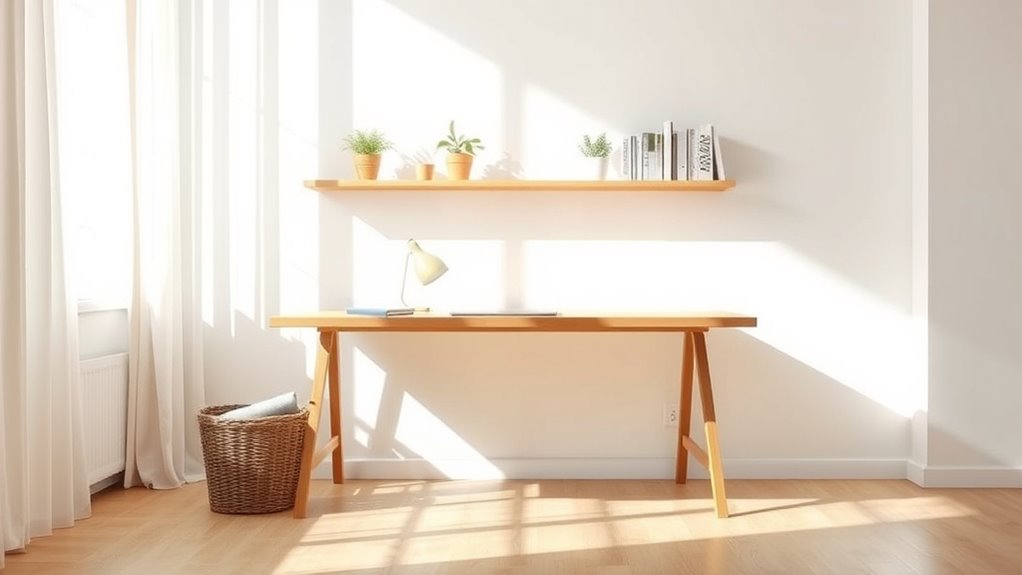
When you're ready to declutter, the first step is to identify your decluttering space. Choose a specific room, like a bedroom or bathroom, to tackle the clutter effectively.
Next, assess the area's condition to gauge how much organization is needed. Identify the types of clutter present, whether it's clothing, papers, or household items, so you can tailor your approach. Starting with a specific area helps maintain focus on one space at a time and makes the task feel less overwhelming.
Assess the condition of the area to determine the level of organization needed and identify the types of clutter present.
Think about how you want the space to look and function after decluttering. Allocate enough time based on the size and complexity of the task.
Prioritize high-traffic areas and storage spaces first, and consider any seasonal changes that may influence your focus. This groundwork sets you up for a successful decluttering journey.
Gather Your Decluttering Supplies
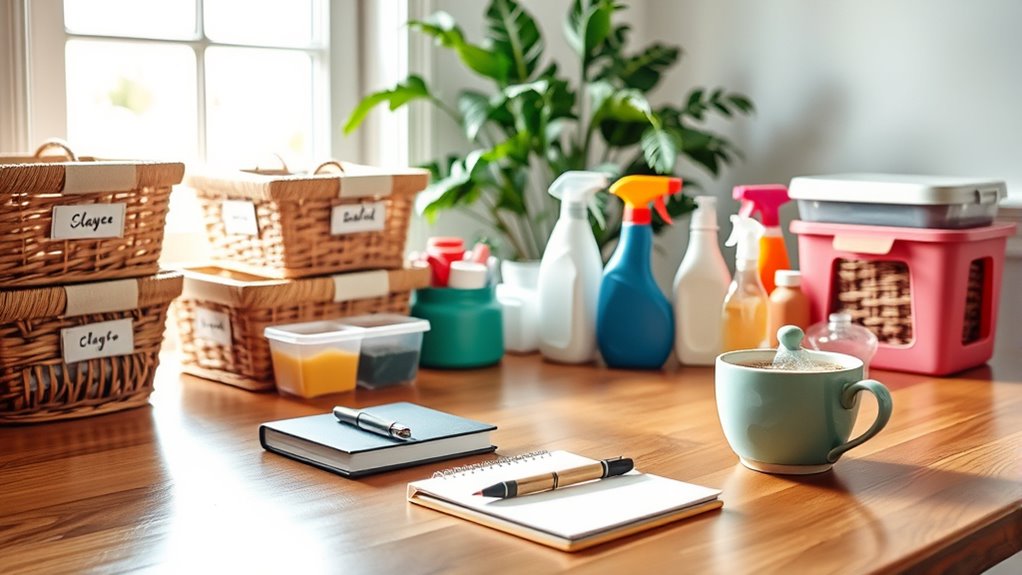
Now that you've identified your decluttering space, it's time to gather your supplies. Start with sturdy boxes for donations, sales, or storage. Don't forget dark trash bags to hide contents and prevent second thoughts. Set up recycling bins for materials you can recycle and grab labels and markers to identify the contents of your boxes. Consider including organizers, like baskets or drawer dividers, to keep everything tidy after decluttering. For cleaning, have dusters, a vacuum, and basic cleaning supplies on hand. If you need to reach high shelves, a step stool is essential. Lastly, grab gloves to protect your hands while sorting through items. Preparing mentally for decision-making challenges is also crucial as you're ready to dive into your decluttering journey!
Set a Timer for Focused Sessions
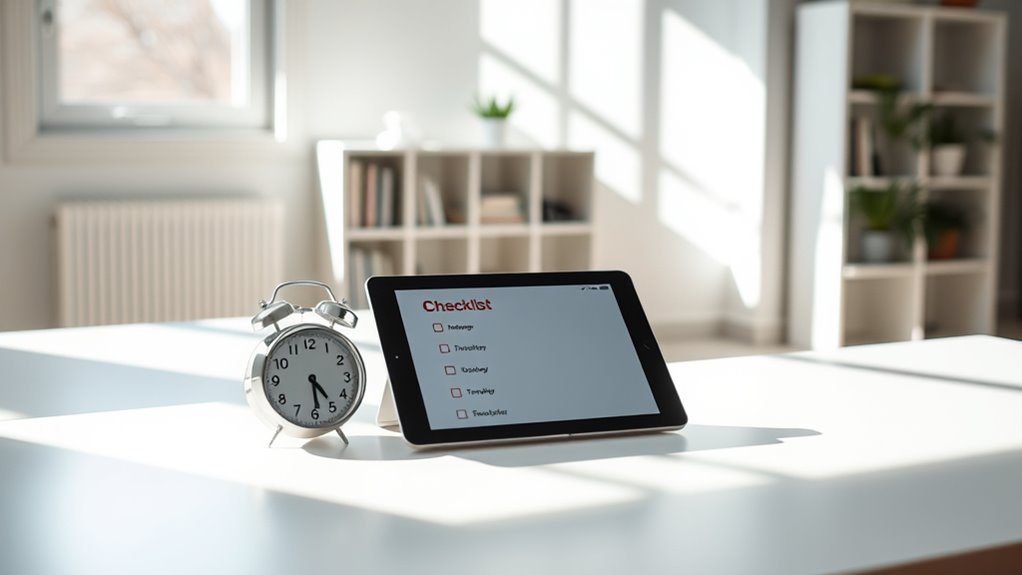
To maximize your decluttering efficiency, setting a timer for focused sessions can make a significant difference. By breaking your tasks into manageable intervals, you enhance your focus and reduce procrastination. Consider using the Pomodoro Technique, which consists of 25-minute work sessions followed by short breaks. This approach not only establishes consistent routines but also keeps you motivated by turning large tasks into smaller, achievable steps. As you declutter, track your progress within these time frames, allowing for regular breaks to avoid burnout. Additionally, studies show 77% of remote workers report higher productivity levels when using structured time management techniques. Tools like timer apps, such as Session, can help you customize sessions, set specific goals, and integrate reminders. Ultimately, this method supports a clean, organized environment while boosting your productivity.
Create a Decluttering Checklist

Creating a decluttering checklist can streamline your organizing process and keep you focused. Start by categorizing items by room, like the entryway, kitchen, and garage. For each room, include specific tasks—remove trash, sort shoes, and eliminate expired food.
Next, apply decluttering rules like the 20/20 Rule or the 12-12-12 Rule to efficiently decide what to keep or discard. Make sure to gather similar items together to assess storage needs and designate spaces for each item.
Use bins and labels to maintain organization and prevent future clutter. Additionally, remember that decluttering improves mental health as it can reduce anxiety and stress. Finally, periodically review your checklist to adapt it to your evolving needs. This approach won't only simplify the process but also help you achieve a clutter-free environment.
Start Small for Quick Wins

Starting with small areas can make a big difference in your decluttering journey. Focus on contained spaces like drawers or shelves, where you can achieve immediate results. Implementing the four-box method can further streamline your decluttering process.
Set realistic timers for tasks—try 10 to 15 minutes to keep burnout at bay. Break down larger projects into manageable chunks, tackling one room or area at a time.
Incorporate quick decluttering tasks, such as sorting papers or clearing expired products, into your daily routine. Celebrate each small victory to boost your motivation and share your progress with others for support. Remember, viewing decluttering as a gradual process helps maintain your momentum and prevents feelings of overwhelm.
Apply the Four-Box Method
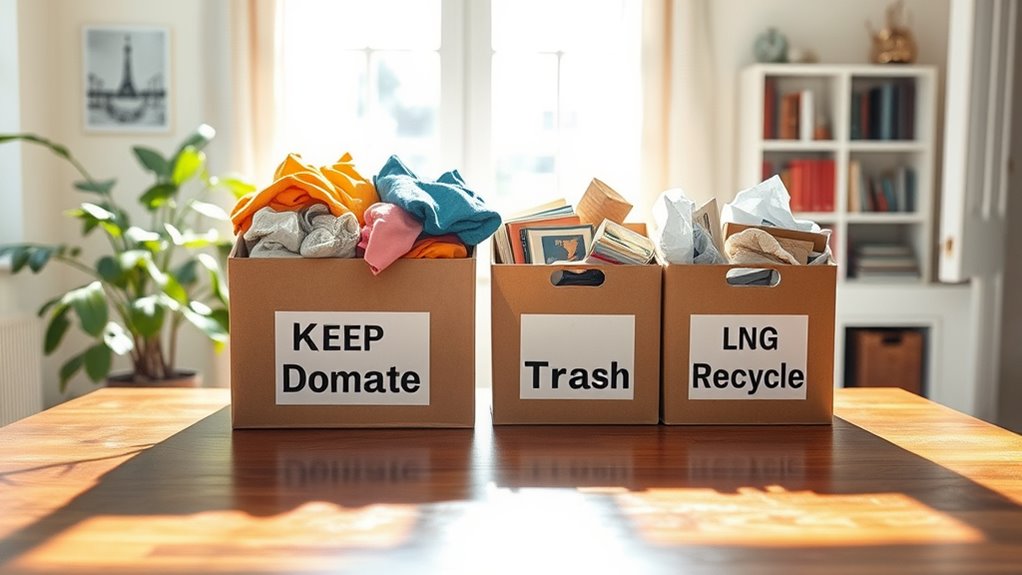
Building on those quick wins, the Four-Box Method offers a structured approach to tackle clutter more effectively. Start by labeling four boxes: Keep, Store, Donate, and Discard. Each box serves a purpose: Keep items you use daily, Store those you value but don't use often, Donate items in good condition, and Discard those beyond repair. To begin, choose a single room and focus on one item at a time—this prevents overwhelm and helps you make thoughtful decisions. Use clear labels and adjust box sizes based on your space. This method encourages you to assess frequency of use for each item, ensuring that your decisions are more intentional.
Organize and Store Efficiently
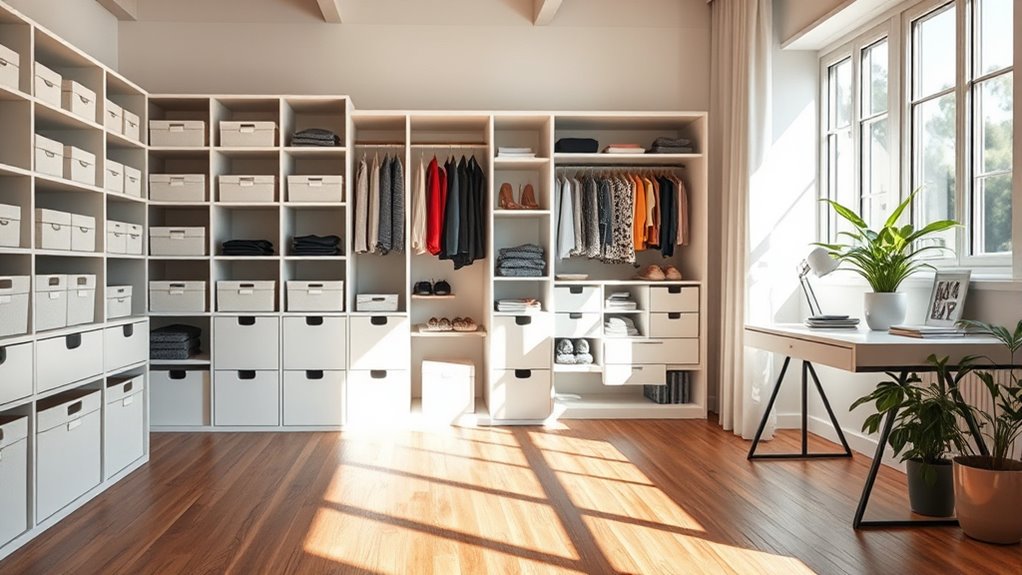
Effective organization and storage can transform your space and boost productivity. Start by utilizing shelving units to maximize vertical space, and consider implementing pallet racks for bulk items. Use bins and dividers to compartmentalize inventory, making everything more accessible. Regularly review your storage capacity to ensure you're using every inch efficiently. Tailor your storage solutions to fit various item sizes and shapes, preventing clutter. Implementing a well-organized stockroom can significantly enhance operational efficiency and customer satisfaction.
Create logical layouts by mapping out your space, designating zones for different product categories, and positioning high-demand items for easy access. Regularly review these layouts to adapt to your evolving needs, ensuring a streamlined and efficient environment.
Manage Clutter in Specific Areas
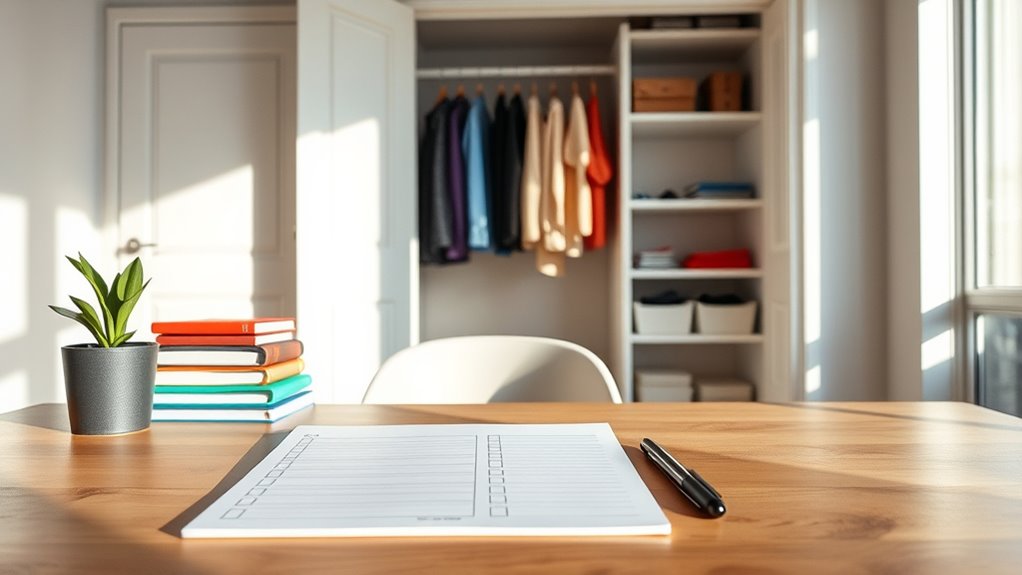
While you might feel overwhelmed by clutter in specific areas of your home, tackling it systematically can lead to a more organized and serene environment.
Start with your kitchen: clear countertops by storing frequently used items nearby and utilize vertical space with shelves or hooks. Organize your pantry with labeled containers and categorize food types.
For clothing, sort items into keep, donate, and discard piles, and implement a seasonal rotation. In high-traffic areas like entryways, use hooks for coats and install a shoe rack.
Finally, manage digital and paper clutter by creating folders for files, using a scanner for documents, and setting a "touch once" policy. Regularly evaluate the importance of each document to keep chaos at bay. Regularly tidying these spaces will keep chaos at bay.
Maintain a Clutter-Free Environment
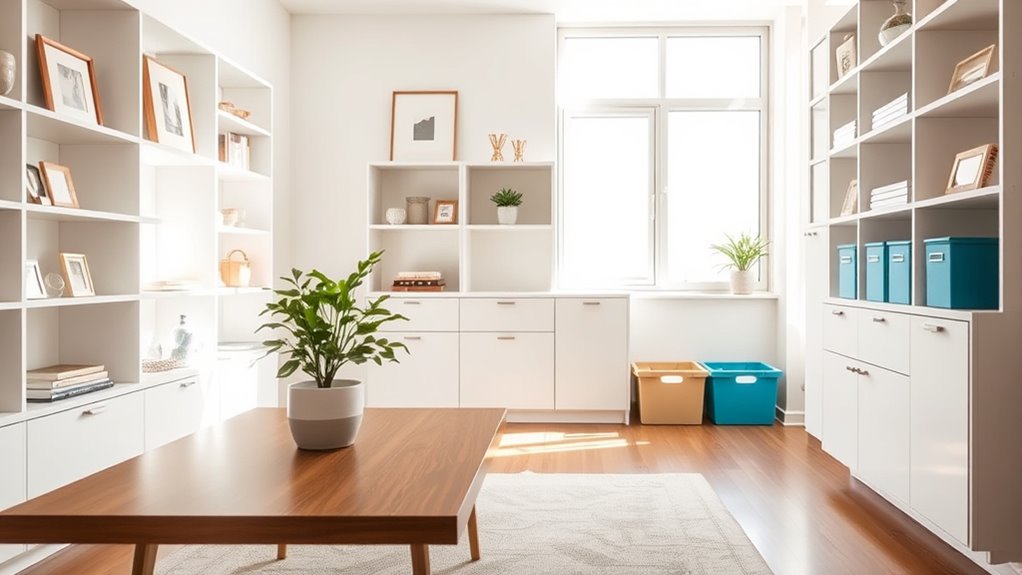
Once you've tackled specific areas of clutter, maintaining a clutter-free environment becomes the next priority.
To keep your space organized, adopt the one in, one out rule—every time you bring something new home, remove an old item. This practice aligns with the concept of mindful living, encouraging intentional consumption.
Implement the four-box method to sort belongings regularly into trash, donate, relocate, and keep.
Establish designated spaces for everything and utilize vertical storage to maximize your area.
Daily routines help prevent clutter buildup, while seasonal decluttering keeps things in check.
Involve your family in these efforts to share the responsibility.
Remember, embracing minimalism and practicing patience are key.
With consistent effort, you'll enjoy a tidy, stress-free environment that promotes peace and productivity.
Frequently Asked Questions
How Often Should I Declutter My Home?
You should declutter your home regularly to maintain order and reduce stress. Daily tasks like clearing counters can keep clutter at bay, while weekly check-ins in high-traffic areas help too.
Monthly organizing of closets and paperwork is beneficial, and seasonal decluttering lets you reassess items like clothing.
If your household dynamics change or you accumulate new items, adjust your decluttering frequency accordingly to stay ahead of the clutter.
What Should I Do With Sentimental Items?
When dealing with sentimental items, start by gathering them in one place to evaluate their significance.
Ask yourself how each item makes you feel and whether it still serves a purpose in your life. Consider taking photos to preserve memories without keeping everything.
Set limits on how much you keep, and remember, it's okay to let go. Sharing stories about the items can help ease emotional attachment as you declutter effectively.
How Do I Handle Clutter From Kids?
Did you know that children can accumulate over 200 toys by the age of five?
To handle clutter from kids, start by involving them in the decluttering process. Encourage them to choose which items to keep or donate. Use labeled bins to store toys, maintaining organization.
Set regular decluttering sessions, and make it fun by turning it into a game. This way, you teach them valuable decision-making skills while keeping clutter at bay.
What if I Can't Decide What to Keep?
If you can't decide what to keep, start by simplifying the process.
Focus on easy choices first, like items you haven't used in over a year. Avoid diving into sentimental items right away; they can cloud your judgment.
Set a timer for short decluttering sessions to keep your energy up. Ask yourself practical questions, like, "Do I really need this?"
This way, you'll make clearer decisions without feeling overwhelmed.
How Can I Motivate Family Members to Declutter?
Motivating family members to declutter can feel like herding cats, but it's doable!
Start by involving everyone in setting personal goals and creating a shared vision of a clutter-free space. Assign tasks based on interests, and work together on common areas.
Celebrate each small win to keep spirits high. Make it fun with music or podcasts, and educate them on the benefits of decluttering.
Lead by example, and you'll inspire them to join in!
Conclusion
Congratulations, you're now a decluttering guru! Just remember, if you can't find your favorite sweater after your epic purge, it's probably in the "donate" box—don't worry, it's in good hands… somewhere. Maintaining a clutter-free space is a constant battle against the sneaky accumulation of stuff, but hey, at least you've got a fancy checklist! So, grab that timer and embrace your inner minimalist warrior. Who knew tidying up could be so exhilarating? Happy decluttering!









